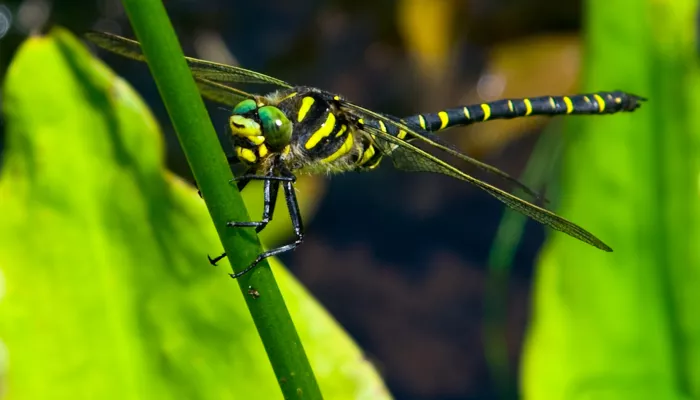Hairy dragonfly
The UK's smallest hawker, the Hairy dragonfly is mostly black in colour, but has a distinctively hairy thorax. It can be found in grazing marshes and flooded gravel pits, and along canals from spring.

Discover the most successful hunters in the UK, dragonflies. Use our handy species guides to learn about them and how to identify them.
The UK's smallest hawker, the Hairy dragonfly is mostly black in colour, but has a distinctively hairy thorax. It can be found in grazing marshes and flooded gravel pits, and along canals from spring.
A large hawker, the Common Hawker can be seen throughout the summer and into autumn. A fast-flying insect, it catches its prey mid-air. Look for it around ponds in the uplands of the north and west.
The Migrant hawker is not a particularly aggressive species, and may be seen feeding in large groups. It flies late into autumn and can be seen in gardens, grasslands and woodlands.
A common dragonfly of ponds, lakes and canals near woodland, the Southern Hawker can be seen patrolling the water or 'hawking' through woodland rides. A fast-flying species, it will catch its prey mid-air.
A common dragonfly of canals, marshes, reedbeds and lakes, the Brown hawker can be seen patrolling the water or 'hawking' through woodland rides. It is easily distinguished by its chocolate-brown body.
The rare Norfolk hawker is a pale brown dragonfly, with a distinctive yellow triangle on its body. It is only found in unpolluted fens, marshes and ditches of the Broads National Park in Norfolk and Suffolk.
The emperor dragonfly is an impressively large and colourful dragonfly of ponds, lakes, canals and flooded gravel pits. It flies between June and August and even eats its prey on the wing.
A voracious predator that will even eat other dragonflies, the golden-ringed dragonfly is the UK's longest species. It can be found around acidic streams in moorland and heathland habitats.
The Four-spotted chaser is easily recognised by the two dark spots on the leading edge of each wing - giving this species its name. It can be seen on heathlands and near ponds and lakes.
The Broad-bodied chaser is a common dragonfly that can be seen in summer around ponds and lakes, and even in gardens. It lives up to its name: its flattened body gives it a fat, broad look.
The Black-tailed skimmer is a narrow-bodied dragonfly that can be seen flying low over the bare gravel and mud around flooded gravel pits and reservoirs. It is on the wing from May to August.
The Common darter is a red, narrow-bodied dragonfly that can be seen throughout summer and autumn. It is hovers around all kinds of waterbodies, darting out to surprise its prey.
The Black darter is a black, narrow-bodied dragonfly that can be seen throughout summer and autumn. It is hovers around damp moors, heaths and bogs, darting out to surprise its prey.
The Keeled skimmer is a dragonfly of heaths and commons with shallow pools. It has a skittish and weak flight, and is on the wing in summer and early autumn.
The Common clubtail is on the wing in spring and summer. It is an elusive dragonfly that is easiest to see when it first emerges. It can be found along rivers in Southern England and Wales.
This dazzling dragonfly can be seen darting above tree-lined ponds in certain parts of Britain.